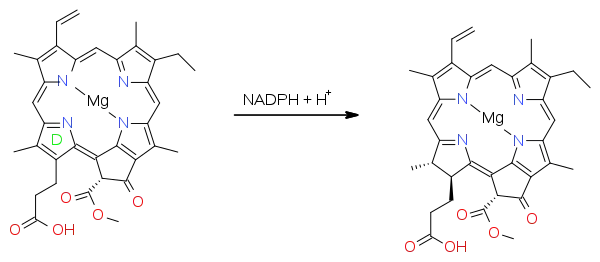Protochlorophyllide reductase
In enzymology, protochlorophyllide reductases[2][3] (EC 1.3.1.33 and EC 1.3.7.7) are enzymes that catalyze the chemical reaction

- protochlorophyllide + NADPH + H+ chlorophyllide a + NADP+
| light-dependent protochlorophyllide reductase | |||||||||
|---|---|---|---|---|---|---|---|---|---|
| Identifiers | |||||||||
| EC number | 1.3.1.33 | ||||||||
| CAS number | 68518-04-7 | ||||||||
| Databases | |||||||||
| IntEnz | IntEnz view | ||||||||
| BRENDA | BRENDA entry | ||||||||
| ExPASy | NiceZyme view | ||||||||
| KEGG | KEGG entry | ||||||||
| MetaCyc | metabolic pathway | ||||||||
| PRIAM | profile | ||||||||
| PDB structures | RCSB PDB PDBe PDBsum | ||||||||
| Gene Ontology | AmiGO / QuickGO | ||||||||
| |||||||||
| light-independent protochlorophyllide reductase | |||||||||
|---|---|---|---|---|---|---|---|---|---|
 Crystallographic structure of heterooctamer of a dark-operative protochlorophyllide oxidoreductase from Prochlorococcus marinus.[1] | |||||||||
| Identifiers | |||||||||
| EC number | 1.3.7.7 | ||||||||
| Databases | |||||||||
| IntEnz | IntEnz view | ||||||||
| BRENDA | BRENDA entry | ||||||||
| ExPASy | NiceZyme view | ||||||||
| KEGG | KEGG entry | ||||||||
| MetaCyc | metabolic pathway | ||||||||
| PRIAM | profile | ||||||||
| PDB structures | RCSB PDB PDBe PDBsum | ||||||||
| |||||||||
The three substrates of this enzyme are protochlorophyllide, NADPH, and H+; its two products are chlorophyllide a and NADP+ .
This enzyme belongs to the family of oxidoreductases. The systematic name of this enzyme class is chlorophyllide-a :NADP+ 7,8-oxidoreductase. Other names in common use include NADPH2-protochlorophyllide oxidoreductase, NADPH-protochlorophyllide oxidoreductase, NADPH-protochlorophyllide reductase, protochlorophyllide oxidoreductase, and protochlorophyllide photooxidoreductase. This enzyme is part of the biosynthetic pathway to chlorophylls.[4][5]
There are two structurally unrelated proteins with this activity, referred to as light-dependent and the dark-operative. The light-dependent reductase needs light to function, while the dark-operative version is a completely different protein, consisting of three subunits that exhibit significant sequence similarity to the three subunits of nitrogenase.[6] This enzyme might be evolutionary older but (being similar to nitrogenase) is highly sensitive to free oxygen and does not work if its concentration exceeds about 3%.[7] Hence the alternative, light dependent version evolved as the concentration of oxygen in the earth's atmosphere grew.
See also
References
- PDB: 2ynm; Moser J, Lange C, Krausze J, Rebelein J, Schubert WD, Ribbe MW, Heinz DW, Jahn D (2013). "Structure of ADP-aluminium fluoride-stabilized protochlorophyllide oxidoreductase complex". Proc Natl Acad Sci U S A. 110 (6): 2094–2098. Bibcode:2013PNAS..110.2094M. doi:10.1073/pnas.1218303110. PMC 3568340. PMID 23341615.
- Griffiths WT (1978). "Reconstitution of chlorophyllide formation by isolated etioplast membranes". Biochem. J. 174 (3): 681–92. PMC 1185970. PMID 31865.
- Apel K, Santel HJ, Redlinger TE, Falk H (1980). "The protochlorophyllide holochrome of barley (Hordeum vulgare L.) Isolation and characterization of the NADPH:protochlorophyllide oxidoreductase". Eur. J. Biochem. 111 (1): 251–8. doi:10.1111/j.1432-1033.1980.tb06100.x. PMID 7439188.
- Willows, Robert D. (2003). "Biosynthesis of chlorophylls from protoporphyrin IX". Natural Product Reports. 20 (6): 327–341. doi:10.1039/B110549N. PMID 12828371.
- Bollivar, David W. (2007). "Recent advances in chlorophyll biosynthesis". Photosynthesis Research. 90 (2): 173–194. doi:10.1007/s11120-006-9076-6. PMID 17370354.
- Yuichi FujitaDagger and Carl E. Bauer (2000). Reconstitution of Light-independent Protochlorophyllide Reductase from Purified Bchl and BchN-BchB Subunits. J. Biol. Chem., Vol. 275, Issue 31, 23583-23588.
- S.Yamazaki, J.Nomata, Y.Fujita (2006) Differential operation of dual protochlorophyllide reductases for chlorophyll biosynthesis in response to environmental oxygen levels in the cyanobacterium Leptolyngbya boryana. Plant Physiology, 2006, 142, 911-922
